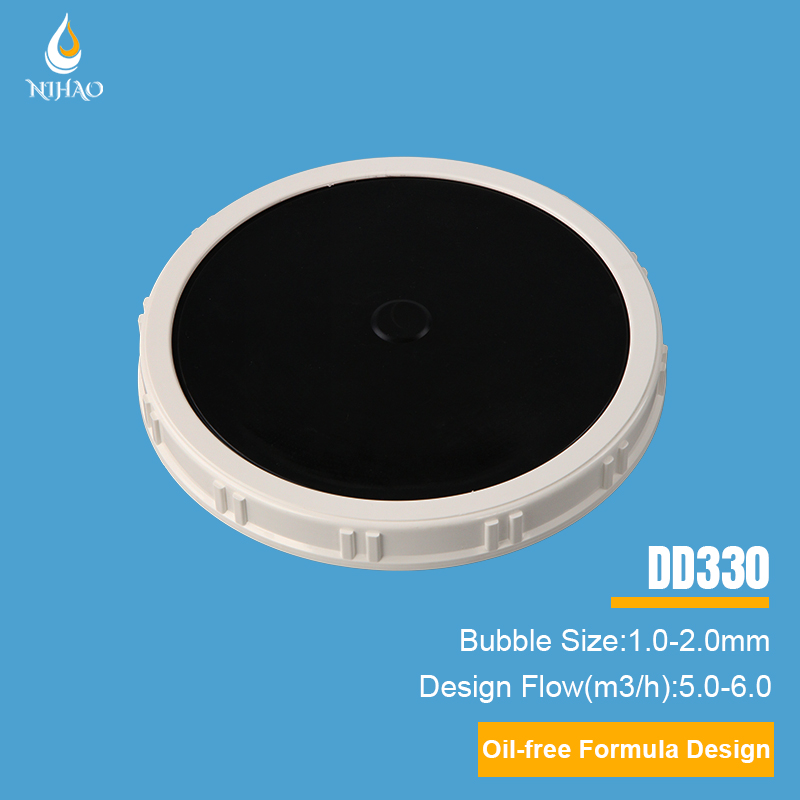 +86-15267462807
+86-15267462807
Fine bubble technology, particularly disc diffusers, plays a significant role in enhancing oxygen transfer efficiency in water treatment processes. The primary purpose of using disc diffusers is to introduce oxygen into the water effectively. This process is crucial for maintaining the desired oxygen levels in various applications such as wastewater treatment, aquaculture, and industrial processes.
Disc diffusers are devices specifically designed to create and release fine bubbles into the water. These diffusers consist of a circular disc with tiny perforations or slots that allow air to escape in the form of small bubbles. The fine bubble size generated by disc diffusers contributes to improved oxygen transfer rates compared to larger bubbles.
Increased surface area: The fine bubble size generated by disc diffusers leads to a larger surface area of contact between the water and the oxygen bubbles. The increased surface area allows for more efficient transfer of oxygen from the bubbles to the water.
In wastewater treatment plants, disc diffusers are commonly used in activated sludge processes. The fine bubbles generated by disc diffusers increase the surface area of contact between the microorganisms in the sludge and the oxygen bubbles. This promotes the growth of aerobic bacteria, which efficiently break down organic matter in the wastewater. The design of disc diffusers, such as the spacing and density of the perforations, is optimized to achieve the desired bubble size and distribution. This ensures maximum surface area contact and oxygen transfer efficiency.
Longer residence time: The small size of the bubbles produced by disc diffusers increases their buoyancy, allowing them to remain suspended in the water for a longer time. This extended residence time provides more opportunities for oxygen molecules to dissolve into the water.
In fish farms and aquaculture systems, disc diffusers are utilized to maintain adequate oxygen levels for fish and other aquatic organisms. The small bubbles produced by the diffusers remain suspended in the water for an extended period, allowing fish to extract oxygen efficiently from the water through their gills. The depth and placement of disc diffusers in aquatic systems are crucial for optimizing residence time. By strategically positioning the diffusers at different depths, oxygen can be evenly distributed throughout the water column, ensuring all aquatic organisms have access to sufficient oxygen.
Uniform distribution: Disc diffusers are strategically placed across the water treatment system to ensure uniform distribution of bubbles throughout the water column. This uniform distribution helps maintain consistent oxygen levels and prevents oxygen depletion in specific areas.
In industrial wastewater treatment, disc diffusers are employed in aerobic bioreactors to provide oxygen for microbial degradation of pollutants. The diffusers are evenly distributed across the bioreactor, ensuring uniform oxygen distribution and preventing the formation of oxygen-depleted zones. The spacing and arrangement of disc diffusers depend on the specific design of the treatment system. Computational fluid dynamics (CFD) modeling and experimentation are often used to determine the optimal diffuser layout to achieve uniform oxygen distribution.
Reduced bubble coalescence: Fine bubbles generated by disc diffusers are less prone to coalesce or combine into larger bubbles. When bubbles combine, they lose surface area and decrease their oxygen transfer efficiency. The prevention of bubble coalescence ensures that the oxygen transfer process remains optimal.
In the aeration tanks of municipal wastewater treatment plants, disc diffusers prevent the coalescence of bubbles, ensuring efficient oxygen transfer. If larger bubbles were formed due to coalescence, they would rise quickly to the water's surface, reducing their contact time with the wastewater and impairing oxygen transfer efficiency. Disc diffusers are designed to produce fine bubbles that are less likely to coalesce. The choice of materials for the diffusers, such as silicon or EPDM (ethylene propylene diene monomer), also contributes to bubble stability and prevents coalescence.
Energy efficiency: Fine bubble technology, including disc diffusers, is known for its energy efficiency. The small size of the bubbles reduces the energy required for their generation compared to larger bubble sizes. This results in lower energy consumption during the aeration process.
Fine bubble technology, including disc diffusers, is widely used in the aeration systems of municipal wastewater treatment plants. These diffusers consume less energy compared to traditional coarse bubble diffusers while achieving the same or even higher oxygen transfer rates. The energy savings contribute to reduced operational costs. The selection of disc diffusers should consider factors such as the desired oxygen transfer efficiency, pressure loss, and compatibility with the treatment system. We are leading DISC DIFFUSER Manufacturer which provide performance data, including oxygen transfer efficiency and energy consumption, to guide the selection of the most suitable disc diffuser for a specific application.